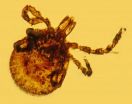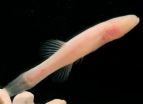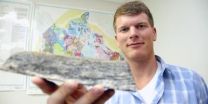(Press-News.org) CORVALLIS, Ore. – Lyme disease is a stealthy, often misdiagnosed disease that was only recognized about 40 years ago, but new discoveries of ticks fossilized in amber show that the bacteria which cause it may have been lurking around for 15 million years – long before any humans walked on Earth.
The findings were made by researchers from Oregon State University, who studied 15-20 million-year-old amber from the Dominican Republic that offer the oldest fossil evidence ever found of Borrelia, a type of spirochete-like bacteria that to this day causes Lyme disease. They were published in the journal Historical Biology.
In a related study, published in Cretaceous Research, OSU scientists announced the first fossil record of Rickettsial-like cells, a bacteria that can cause various types of spotted fever. Those fossils from Myanmar were found in ticks about 100 million years old.
As summer arrives and millions of people head for the outdoors, it's worth considering that these tick-borne diseases may be far more common than has been historically appreciated, and they've been around for a long, long time.
"Ticks and the bacteria they carry are very opportunistic," said George Poinar, Jr., a professor emeritus in the Department of Integrative Biology of the OSU College of Science, and one of the world's leading experts on plant and animal life forms found preserved in amber. "They are very efficient at maintaining populations of microbes in their tissues, and can infect mammals, birds, reptiles and other animals.
"In the United States, Europe and Asia, ticks are a more important insect vector of disease than mosquitos," Poinar said. "They can carry bacteria that cause a wide range of diseases, affect many different animal species, and often are not even understood or recognized by doctors.
"It's likely that many ailments in human history for which doctors had no explanation have been caused by tick-borne disease."
Lyme disease is a perfect example. It can cause problems with joints, the heart and central nervous system, but researchers didn't even know it existed until 1975. If recognized early and treated with antibiotics, it can be cured. But it's often mistaken for other health conditions. And surging deer populations in many areas are causing a rapid increase in Lyme disease – the confirmed and probable cases of Lyme disease in Nova Scotia nearly tripled in 2013 over the previous year.
The new research shows these problems with tick-borne disease have been around for millions of years.
Bacteria are an ancient group that date back about 3.6 billion years, almost as old as the planet itself. As soft-bodied organisms they are rarely preserved in the fossil record, but an exception is amber, which begins as a free-flowing tree sap that traps and preserves material in exquisite detail as it slowly turns into a semi-precious mineral.
A series of four ticks from Dominican amber were analyzed in this study, revealing a large population of spirochete-like cells that most closely resemble those of the present-day Borrelia species. In a separate report, Poinar found cells that resemble Rickettsia bacteria, the cause of Rocky Mountain spotted fever and related illnesses. This is the oldest fossil evidence of ticks associated with such bacteria.
In 30 years of studying diseases revealed in the fossil record, Poinar has documented the ancient presence of such diseases as malaria, leishmania, and others. Evidence suggests that dinosaurs could have been infected with Rickettsial pathogens.
Humans have probably been getting diseases, including Lyme disease, from tick-borne bacteria as long as there have been humans, Poinar said. The oldest documented case is the Tyrolean iceman, a 5,300-year-old mummy found in a glacier in the Italian Alps.
"Before he was frozen in the glacier, the iceman was probably already in misery from Lyme disease," Poinar said. "He had a lot of health problems and was really a mess."
INFORMATION:
Editor's Note: Digital images are available to illustrate this story.
Tick carrying spirochetes: http://bit.ly/RCFVzp
Spirochetes of type that carry lyme disease: http://bit.ly/1msuLHk
Rickettsia-like cells preserved in amber: http://bit.ly/1msy7d9
Tick carrying rickettsia bacteria: http://bit.ly/1nDCyES
Amber discovery indicates Lyme disease is older than human race
2014-05-29
ELSE PRESS RELEASES FROM THIS DATE:
Remember parathyroid hormone as well as vitamin D to assess vitamin's role in diabetes
2014-05-29
TORONTO -- Combined assessment of parathyroid hormone along with vitamin D may be needed to assess the impact of vitamin D status on sugar metabolism, according to Toronto researchers. Their study is published on-line in Diabetes on May 29 2014.
The new findings might explain why studies of vitamin D alone have been conflicting and why clinical trials of vitamin D supplementation to improve diabetes have been disappointing, says principal investigator Dr. Ravi Retnakaran. He is a clinician-scientist at the Lunenfeld-Tanenbaum Research Institute at Mount Sinai Hospital ...
Grape-enriched diet supports eye health
2014-05-29
FRESNO, CA – New research presented this week at the Association for Research in Vision and Ophthalmology conference in Orlando, Florida suggests that regular grape consumption may play a role in eye health by protecting the retina from deterioration. Specifically, a grape-enriched diet resulted in a protective effect on retinal structure and function.
The retina is the part of the eye that contains the cells that respond to light, known as photoreceptors. There are two types of photoreceptors: rods and cones. Retinal degenerative diseases affect over 5 million people ...
First-of-its-kind study: Swimmers gain an advantage when they recover with chocolate milk
2014-05-29
Grabbing chocolate milk after a hard swim could give swimmers a performance edge, according to new research presented at one of the nation's top sports medicine conferences – the American College of Sports Medicine's annual conference.1 In a sport where seconds and even tenths of a second can make a big difference and intense practice routines are the norm, Indiana University researchers found that when collegiate, trained swimmers recovered with chocolate milk after an exhaustive swim, they swam faster in time trials later that same day. On average, they shaved off 2.1 ...
The Hoosier Cavefish, a new and endangered species from the caves of southern Indiana
2014-05-29
A new eyeless cavefish is described from Indiana and named after the Indiana Hoosiers. It is the first new cavefish species described from the U.S. in 40 years. Notably, it has an anus right behind its head, and the females brood their young in their gill chamber. The new species was described in the open access journal ZooKeys.
The new species, Amblyopsis hoosieri, is the closest relative of a species (A. spelaea) from the longest cave system in the world, Mammoth Cave in Kentucky. These two species are separated by the Ohio River, which also separates the states of ...
Think fast, robot
2014-05-29
One of the reasons we don't yet have self-driving cars and mini-helicopters delivering online purchases is that autonomous vehicles tend not to perform well under pressure. A system that can flawlessly parallel park at 5 mph may have trouble avoiding obstacles at 35 mph.
Part of the problem is the time it takes to produce and interpret camera data. An autonomous vehicle using a standard camera to monitor its surroundings might take about a fifth of a second to update its location. That's good enough for normal operating conditions but not nearly fast enough to handle ...
Minority entrepreneurs face discrimination when seeking loans
2014-05-29
A disheartening new study from researchers at Utah State University, BYU and Rutgers University reveals that discrimination is still tainting the American Dream for minorities.
The three-part research article, which appears online in the Journal of Consumer Research, finds that minorities seeking small business loans are treated differently than their white counterparts, despite having identical qualifications on paper.
While discrimination in housing, employment and education is well documented, the study shows that minorities also face discrimination in the marketplace. ...
Four-billion-year-old rocks yield clues about Earth's earliest crust
2014-05-29
(Edmonton) It looks like just another rock, but what Jesse Reimink holds in his hands is a four-billion-year-old chunk of an ancient protocontinent that holds clues about how the Earth's first continents formed.
The University of Alberta geochemistry student spent the better part of three years collecting and studying ancient rock samples from the Acasta Gneiss Complex in the Northwest Territories, part of his PhD research to understand the environment in which they formed.
"The timing and mode of continental crust formation throughout Earth's history is a controversial ...
Diesel bus alternative
2014-05-29
Electric school buses that feed the power grid could save school districts millions of dollars — and reduce children's exposure to diesel fumes — based on recent research by the University of Delaware's College of Earth, Ocean, and Environment (CEOE).
A new study examines the cost-effectiveness of electric school buses that discharge their batteries into the electrical grid when not in use and get paid for the service. The technology, called vehicle-to-grid (V2G), was pioneered at UD and is being tested with electric cars in a pilot project.
Adapting the system for ...
Stress degrades sperm quality
2014-05-29
Psychological stress is harmful to sperm and semen quality, affecting its concentration, appearance, and ability to fertilize an egg, according to a study led by researchers Columbia University's Mailman School of Public Health and Rutgers School of Public Health. Results are published online in the journal Fertility and Sterility.
According to the American Society for Reproductive Medicine, infertility affects men and women equally, and semen quality is a key indicator of male fertility.
"Men who feel stressed are more likely to have lower concentrations of sperm ...
Rare skin cancer on palms and soles more likely to come back compared to other melanomas
2014-05-29
A rare type of melanoma that disproportionately attacks the palms and soles and under the nails of Asians, African-Americans, and Hispanics, who all generally have darker skins, and is not caused by sun exposure, is almost twice as likely to recur than other similar types of skin cancer, according to results of a study in 244 patients.
The finding about acral lentiginous melanoma, as the potentially deadly cancer is known, is part of a study to be presented May 31 by researchers at the Perlmutter Cancer Center of NYU Langone at the annual meeting of the American Society ...




